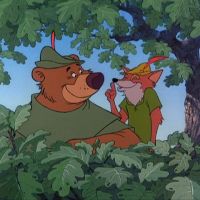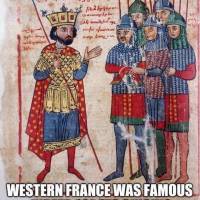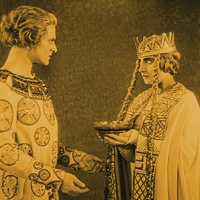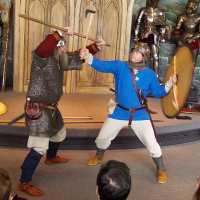There are many fantasy novels set in fictional medieval worlds that share very little of the medieval worldview with us. One barely needs to remove a single suit of shining armor to reveal that most fantasy stories have very little in common with the medieval world besides wardrobe. I’m not saying that people who write fantasy need to make it clear in their text that they can distinguish Thomas Malory from Chrétien de Troyes or Beowulf from Sigurd, but I love it when a fantasy author borrows a cliché, a custom, an object, a theme, or a philosophy from a medieval text and fits it snugly into his own story, effectively evoking medieval essence without disturbing the modern narrative. After all, that’s what medieval storytelling is all about and it’s a tradition that should continue to thrive. An example of such a borrowing that achieves this “medieval essence” can be found in Lloyd Alexander’s Chronicles of Prydain. Alexander carried a symbol from a popular 14th century English poem, simplified it, yet kept the kernel of its strong positive moral message, and placed it in his own story for a modern popular audience
The Chronicles of Prydain is a children’s fantasy adventure series set in a medieval imaginary world. Its easy dialogue, storybook humor, caricatures of Tolkien characters, and often predictable story grant it entrance to the children’s fantasy genre, but Alexander added a special depth to his narrative with simple, yet rich glimpses into the wisdom of the medieval worldview.
One such example occurs In The Black Cauldron, the second book of Chronicles of Prydain. In the story, the young hero Taran is on a quest to rescue a magic cauldron from the clutches of an evil lord who uses the anciently powerful object as a sort of weapon of mass destruction involving zombies. During his quest, Adaon, the son of a chief bard, presents Taran with a brooch. Taran discovers that this brooch gives him dream visions with glimpses of future events. Piecing these glimpses of future events together aids him in his quest to save Prydain, the imaginary world where the story is set. In addition to this magical quality, the brooch is decorated with a symbol that represents a powerful system of virtues that is very similar both in concept and appearance to the Pentangle on Gawain’s shield in Sir Gawain and the Green Knight.
Since Alexander’s readers are quite younger than the 14th century court audiences that enjoyed Sir Gawain and the Green Knight, he created a symbol that is less complex than Gawain’s Pentangle. Although the brooch’s symbol is less complex than the Pentangle in terms of the number of virtues it represents and it lacks Christian iconography, it retains and effectively communicates the same fundamental concept of its 14th century ancestor.
As Taran & company head for the Marshes of Morva, the bard Fflewddur takes a closer look at the brooch which is fastened to Taran’s neck. After examining it, he reveals to Taran that, “it bears the bardic symbol – those three lines there, like a sort of arrowhead.”[1] Fflewddur explains that the three lines symbolize respectively, “knowledge, truth, and love.”[2] Fflewddur then comments on the value and rarity of these virtues, “I sometimes think it’s hard enough to find any one of them, even separately. Put them all together and you have something very powerful indeed.”[3]
The Pentangle painted in pure gold on Gawain’s shield represents “something very powerful” as well. The narrator (often referred to by medieval scholars as the Gawain poet or the Pearl poet) of Sir Gawain and the Green Knight uses forty two lines of his poem to provide his audience with a detailed description of the system of balanced virtues that the Pentangle symbolizes.
The Gawain poet narrator describes the Pentangle as a system of virtues organized by five sets of five. Each point of the star symbolizes five different things, and each of these five things corresponds symbiotically with the other sets of five. To briefly enumerate the five equal layers of the system, the five points represent the five wits, the five fingers of Gawain’s hand, the five wounds Christ suffered on the cross, the five joys that the Virgin Mary had in her child, and the five pure virtues: frankness, fellowship, cleanness, courtesy, and compassion.
The Gawain poet then tells the audience that these attributes are interconnected:
|
Now alle these five sythez, for soothe, were fetled on this knyght,
And uchone halched in other, that non ende hade,
And fyched upon five poyntez, that fayld never,
Ne samned never in no side, ne sundred nouther,
Withouten ende at any noke I oquere fynde,
Whereever the gomen bygan, or glod to an ende. (Fitt 2, v. 656-61)[4] |
Now truly, all these five groups were embodied in that knight,
Each one linked to the others in an endless design,
Based upon five points that was never unfinished,
Not uniting in one line nor separating either;
Without ending anywhere at any point that I find,
No matter where the line began or ran to an end. (Part 2, v. 656-61)[5] |

Detail of lines 656-61 of Sir Gawain and the Green Knight as they appear in MS Cotton Nero A.x. (art. 3). c. 1400 British Library / University of Calgary, Libraries and Cultural Resources. image: http://gawain.ucalgary.ca/
Now, keeping a modern audience’s attention while a five point system which is actually a twenty-five point system is explained in detail would be an incredible feat for today’s storyteller and would require a patient, polite, and engaged audience. A medieval court audience, however, would be quite familiar with the concept of this type of system of organization and would probably be receptive to an even more complex one.
An example of a work where the narrator shares a complex system through which man may achieve spiritual, dietary, moral, and physical balance among the elements (or in Gawain’s case, reaching and maintaining a state of purity) that a medieval court audience would be familiar with is the Secreta Secretorum. The Secreta Secretorum was one of the most widely read books in 14th century England and France. It “circulated freely in court circles”[6] and was, as Terry Jones puts it, “de rigueur on any [medieval] thinking person’s reading list.”[7] It was a type of advice text that scholars call “medieval Mirrors for Princes.”[8] Secreta Secretorum is presented as material gleaned from letters sent between Aristotle and his student Alexander the Great while Alexander campaigned in Persia. Aristotle organizes various disciplines of study and states of the body into systems of four and describes how these four components correspond both to each other and collectively.
He divides Astronomy, for example, into four components: the position of the stars among themselves, the constellations and their position as it relates to the sun, the quality and the moving of the celestial dome, and the degrees of the rising of the constellations that reside in the moon’s celestial band (zodiac constellations).
Nowe to oure first mater and purpose, it is to wite, In the ordinaunce of the sterres; In disposicioun of ϸe signes and alyenyng and mevyng fro ϸe sonne; and this party is called Astronomye; that other part is of qualitees, and also for to knowe the mevyng of ϸe firmament, and the dgrees of ϸe risyng of ϸe signes that are vndir the firmament of ϸe mone, and this is the most worthi part of Astronomye, for ϸerin is the cheef knowyng of ϸat science. (Cap. 28 ll. 26-34)[9]

Image of an early 15th century English Medical Treatise HM 19079. Notice how the article has a heading and notes in the margin. Huntington Library. image: http://sunsite3.berkeley.edu/hehweb/toc.html (Compare to image below of print transcription of Secreta Secretorum)

Detail of transcription of Cap. 28 from MS. Reg. 18 A. vij. B.M. from Three Prose Versions of the Secreta Secretorum. Vol I Ed. Robert Steel (London, 1898) Image: http://books.google.com/
To make an Astronomical conclusion one must consider all four of these factors, however, data from one category may be used with data from a category of another discipline when answering a question that crosses disciplines. Of course, according to that worldview, to answer any question effectively, it was necessary to cross disciplines – ideally several times. To make it possible to compare the data among the other disciplines, they too were organized into basic divisions of four. They were each thought to influence each other. Aristotle divides the human body into four basic parts: the head, the chest, the stomach, and the genitals. He also organizes humors (tempers or dispositions), elements,[10] and seasons[11] into four qualities. Not every system or exemplum in the text is exclusively organized in units of four, but so many of them are that it seems to be Aristotle’s favorite method of outlining complicated scientific ideas.
Since disease in the medieval world was seen as an imbalance in the way the body and mind interacted with the physical world, symbiotic relationships were considered among the body and the physical world for both the diagnosis and treatment of disease. For example, during spring, Aristotle recommends that one should eat chicken, goat, bitter greens, and milk. It is also the ideal time to “flush out” the toxins that accumulate in the body during winter by inducing sweat, bathing, bloodletting, and eating foods with laxative properties:
“In this tyme shulde chykenys be ete, and kydes and eggis, soure letuse ϸat men calle carlokis, and getis mylke. In this tyme is best to lete blood, for onys than is bettir than thre tymes an other tyme ; and it is good to travayle and to haue thi wombe soluble, and than it is good to swete, to bathe, and to goo, and to ete things that are laxatijf, for alle thing that amendith bi digestioun or by blood letyng it shalle sone retorne and amend in this prime temps .i. veer. ” (Cap. 43 ll. 23-30)[12]
While, during winter he recommends one eat hot meats such as chicken and mutton, figs, nuts, and red wine. He also advises to refrain from laxative foods and bloodletting during winter unless it is absolutely necessary.[13]
The Gawain poet doesn’t provide a treatise on medieval medicine and he certainly doesn’t tell us how eating a certain type of food will affect Gawain’s stomach based on his complexion and temper, the constellations as they relate to the moon, and the season. He does, however, include a detailed description of a system (either historical, legendary, or by personal creation) by which one may achieve moral purity.
It is typical of a medieval poet to impart a moral message to a story and one of the methods the Gawain poet uses is describing the meaning of the Pentangle on Gawain’s shield.[14] Since Sir Gawain and the Green Knight is a tale about a knight from King Arthur’s court who unknowingly agrees to have his virtue tested, the Pentangle’s description appears as Gawain is gearing up to leave King Arthur’s court to meet the Green Knight to receive his long-awaited return blow. The description of Gawain’s shield tells the medieval audience that Gawain will be tested.
The brooch in The Black Cauldron tells the audience, in the same way, that Taran will be tested. Though Gawain isn’t forced to wager with his shield in the same way Taran is with his brooch in the Marshas of Morva, the brooch, like Gawain’s shield, offers protection. Where a shield would protect someone from physical harm in a combat situation, the brooch protects Taran by giving him dream visions that arguably save both his life and his quest, but more importantly, they both serve as a reminder to rely on a system of virtue to guide them through life much the teachings of Secreta Secrtorum are meant to do for a king ruling a state. Simplifying the system by presenting fewer virtues and choosing not to give the three lines multiple layers like the Gawain poet did with the Pentangle, Alexander succeeded in using medieval literary devices to promote a positive moral message within a children’s fantasy story.
The narrator poet of Sir Gawain and the Green Knight describes the significance of the pentangle painted on Gawain’s shield directly to the audience as part of a character portrait. It is typical in medieval narrative poetry for the narrator to give a physical description of characters and to use their clothing and objects they carry with them to give the audience details about their estate (or social class) and personalities. Medieval scholars call this a character portrait. One of the most popular examples of a medieval style character portrait is when Chaucer describes each of the pilgrims during the General Prologue of his Canterbury Tales.
Character portraits can vary in length and they can sometimes give the audience an idea of the poet’s moral or political agenda. In the Gawain poet’s case, we see that he thinks it is very important for the audience to understand (or to know that he understands) the Pentangle’s system of virtues because it takes up half of Gawain’s character portrait. While Alexander used a symbol that evokes a similar values system as the Pentangle, the method he uses to introduce it to the story is different from the one used by the Gawain poet. Alexander describes its symbolism to the audience in a modern way rather than a medieval way.
While the Gawain poet used the narrator’s voice providing a medieval character portrait to describe the Pentangle, Alexander used dialogue by having a character with some knowledge of bardic lore describe the significance of the brooch’s symbol to Taran. Having Fflewddur explain the significance of the brooch to Taran is similar to Aristotle’s method of teaching in the Secreta Secretorum in that you have an older, wiser, and somewhat quirky character providing moral guidance to a young character in an important leadership position.
Though the focus of the Secreta Secretorum as an advice text is on physical, political, and economic survival, Aristotle imparts a system of virtue in his teaching. One gets the sense that “being good” is a fundamental ingredient in the system of good governance outlined in this treatise.
Occasionally, Aristole is very direct in passages like this one where he identifies envy as the mother of lying and hatred as the root of all vices, “enuye is neuyr without lesyngis, the which is roote and mater of alle vicis. Envye engedrith yville spekyng, and of yville speche cometh hatred.” (Cap. 8 ll. 6-9)[15] To balance his sermon on the root of vice, Aristotle later points out that truth brings good faith, justice, friendship, great renown for the leader both at home and abroad, promotes the creation of reasonable laws, and fosters a positive sense of community.[16] These are direct examples, but the tone and underlying philosophy of the text implies that virtue is a necessary component of success.
The teachings in the Secreta Secretorum vary in length. For example, instruction on the proper way to sleep[17] is 27 lines while advice on what sort of clothing a king should wear[18] is only 11 lines, but “each exemplum is short enough to be taken in all at once, aiming for a flash of insight or identification.”[19] Though Aristotle doesn’t use a symbol like Lloyd Alexander and the Gawain poet do, the answers to the great mysteries of life that are explained in the Secreta Secretorum can be summarized in these key points: man should seek harmony by guarding himself from impulsive behavior, stay connected with nature and use his resources in moderation according to its cycles, be kind to his fellow man, and value truth above all. Like Gawain’s Pentangle and Taran’s brooch, the teachings in the Secreta Secretorum also suggest that Alexander the Great will be tested as a ruler.
The physical symbols of Taran’s brooch and Gawain’s Pentangle appear different in many ways on the surface (one is “a sort of arrowhead” and the other is a five pointed star) and Aristotle’s method aims to achieve a “flash of insight” without the use of a physical symbol. Each author incorporates different imagery; the Gawain poet uses Christian imagery while Alexander does not. Alexander doesn’t mention a concept of God at all and while the medieval manuscript of Aristotle’s Secreta Secretorum referenced in this article often mentions God, the scribe who copied it did not include Christ’s name a single time in the text.
These three authors do not use the same number of virtues in their respective values systems, and these systems are introduced to the stories in different ways. The incorporation of a values system in these texts suggests that the Gawain poet, Lloyd Alexander, and Aristotle all agree that every hero or person in a position of power must have a code or values system to guide him. By looking at the different ways values systems appear in stories and comparing the core of the respective values systems they illustrate, we realize this: the symbol we carry with us on our quest is not as important as our will to practice it every step along the way.
[1] Lloyd Alexander, The Black Cauldron (Holt, Rine and Winston: New York, 1965), 117.
[2] Lloyd Alexander, 117.
[4] Sir Gawain and The Green Knight: Middle English Text with facing Translation, Ed., Trans. James Winny (Peterborough, 1992).
[5] Sir Gawain and The Green Knight
[6] Katharine Breen, “A Different Kind of Book for Richard’s Sake: MS Bodley 581 as Ethical Handbook,” The Chaucer Review 45.2 (2010): 131.
[7] Terry Jones, Who Murdered Chaucer? (New York, 2004), 50.
[8] Katharine Breen, 120.
[9] The Secrete of Secretes. Translated from the French (MS. Reg. 18 A. vij. B.M.) from Three Prose Versions of the Secreta Secretorum. Vol I Ed. Robert Steel (London, 1898), 21.
[10] The Secrete of Secretes, 22.
[11] The Secrete of Secretes, 27-29.
[12] The Secrete of Secretes, 27.
[13] The Secrete of Secretes, 29.
[14] Though this article only describes the Pentangle that appears on the front of Gawain’s shield, the interior of the shield is painted with a portrait of the Virgin Mary.
[15] The Secrete of Secretes, 10.
[16] The Secrete of Secretes, (Cap. 8 ll. 16-27) 10.
[17] The Secrete of Secretes, (Cap. 39) 25.
[18] The Secrete of Secretes, (Cap. 13) 12.
[19] Katharine Breen, 132.





























